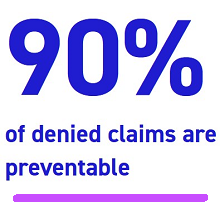How to Handle Payer DRG and SOI Denials that Provide No Detailed ExplanationMalissa Powers, BS, RHIT, CCS, CDIP, CICA | July 7, 2020Although the payer should provide a detailed explanation as to why the claim is being denied, that does not always occur. The best practice is to contact the payer to request this information. However, if the denial is a DRG, APR-DRG, or an SOI (severity of illness) change, it is safe to conclude this is a coding or a clinical validation denial. A total denial in payment would represent a medical necessity denial. Denials for procedures can be tricky as the denial could be for coding, medical necessity, or level of care (place of procedure). When the denial is vague, generic, or provides no rationale, be sure to state that in the introduction of the appeal. For example, “The payer states the claim is not clinically valid; however, the payer did not provide any clinical criteria or references to support the reasoning. Upon review, we respectively disagree.” Explain why you disagree and continue with your appeal. When deciding how to address the denial, a strong multi-disciplinary team approach, including both clinicians and coders, is key. Here are some examples.
The facility reviewer must decide if this is a clinical validation or coding denial. Sometimes this requires a review of the medical record to make that decision. For example, a coder may look at the documentation and find that AKI was documented as a possible diagnosis but not listed on discharge (a common denial). In this example, let’s assume a query confirmed the diagnosis, and the provider completed a coding appeal. The payer then returned a decision referencing how the documentation did not support the AKIN criteria. Now, it is clear this denial is a clinical validation denial. A clinical validation appeal will be necessary for the next level of appeal.
When the clinician reviewed the documentation, they found the patient had a subdural hemorrhage with clear clinical evidence of encephalopathy. The provider submitted a clinical validation appeal to support the clinical diagnosis of encephalopathy. The payer returned a decision stating the patient’s brain bleed was due to a fall. Indexing encephalopathy, in trauma, current injury in the ICD-10-CM codebook leads the coder back to the traumatic bleed code only. Thus, the payer is communicating through the appeal decision that this was a coding denial. The provider now needs to review the documentation again to confirm or refute the payer’s denial rationale for the coding of the case. For scenario 1, the payer was vague. For scenario 2, the payer specifically stated the denial was for clinical validity (but without a detailed explanation of why). It is not uncommon for a payer to use that very language when the denial is actually based on a coding reason. Even when the payer has provided a detailed rationale, they sometimes change their denial rationale after appeal (coding to clinical or vice versa). A strong multi-disciplinary team reviewing the denial and the medical record documentation can often anticipate what the payer’s response will be and be proactive, including those points in the first level of appeal. Clinician reviewers should be aware of basic coding rules and vice versa. Since some facilities have limited resources as to the number of coders and clinicians, they must utilize their staff strategically: Consider denials with vague denial language and understand by historical facility data which denials typically morph into a different issue when not addressed from a dual approach. Is this change most often related to specific diagnoses, specific payers, or both? Once the facility has this information, they can strategically plan how to utilize their internal resources best. For example, if the majority of sepsis denials are clinical validation, then it may be best to have a clinician write those appeals when the payer provides no denial rationale. Consider payers that only allow one level of appeal. If the denial rationale is vague, and there is only one opportunity to appeal, it would be especially advantageous to consider writing these appeals from a multi-disciplinary approach. If no specific codes are listed in the denial, only the DRG, AP-DRG, or SOI changed, then utilize a coder or CDI professional with access to the encoder to determine which specific code(s) are affecting the billed reimbursement. An ideal multi-disciplinary team includes nurses, CDI staff, coders, physicians, and revenue cycle staff. Acknowledge and utilize all your facility resources. Provide staff with education and industry updates regularly. Stay Strong and Appeal On! About the Author: Malissa Powers, B.S., RHIT, CCS, CDIP CICA | Appeal Consultant Intersect Healthcare + AppealMasters Malissa has 20 plus years of experience in the Health Information Management field. She has worked in multiple capacities within the HIM profession to include management and leadership and over 12 years of teaching experience. Malissa has authored hundreds of coding appeals for all levels of denial. She also develops and provides education for successful appeal strategies. Contact the author: [email protected] |




